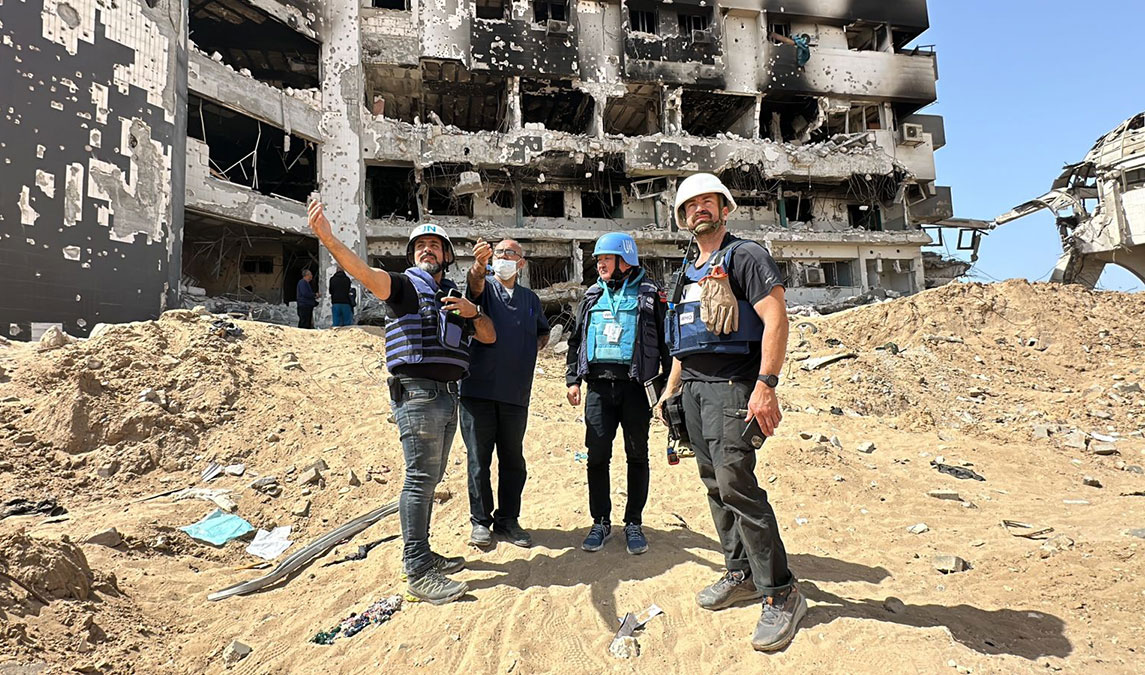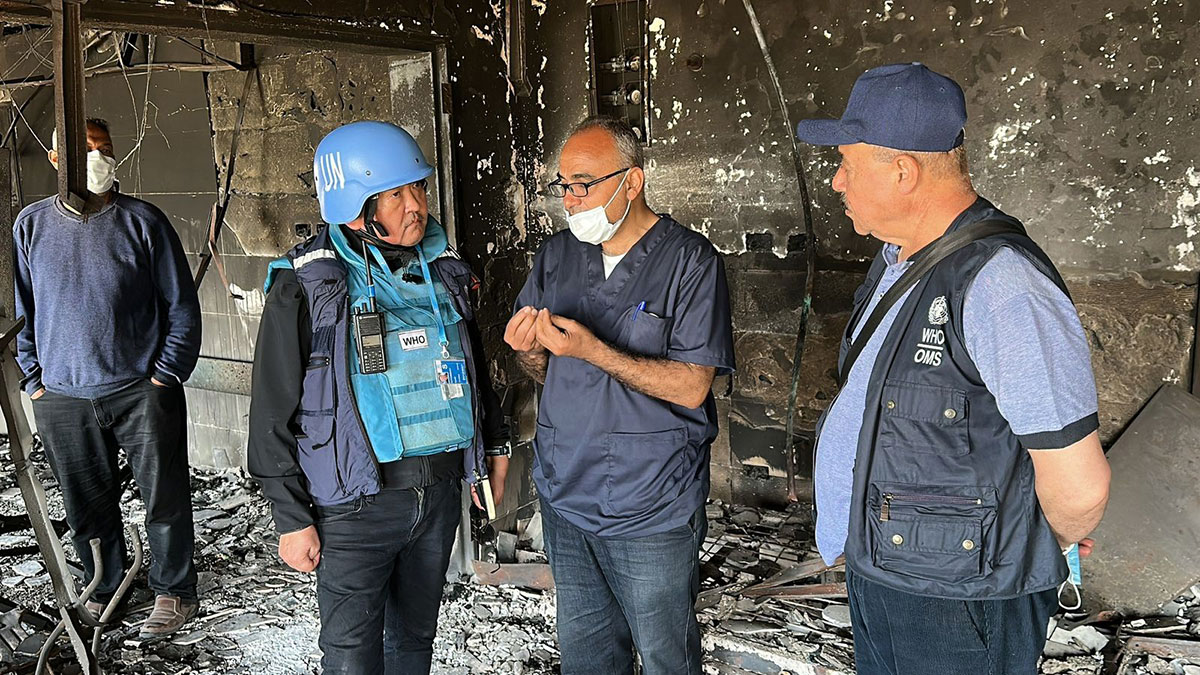6 April 2024, Jerusalem, Cairo, Geneva - A WHO-led multi-agency mission accessed Al-Shifa Hospital in north Gaza on 5 April to conduct a preliminary assessment of the extent of destruction and identify needs to guide future efforts to restore the facility. The highly complex mission was conducted in close partnership with the United Nations Office for the Coordination of Humanitarian Affairs (OCHA), United Nations Mine Action Service (UNMAS), United Nations Department for Safety and Security (UNDSS), and in collaboration with the acting Hospital Director.
Prior to the mission, WHO’s efforts to reach the hospital to medically evacuate patients and staff and conduct an assessment were denied, delayed or impeded six times between 25 March and 1April.
Like the majority of the north, Al-Shifa Hospital – once the largest and most important referral hospital in Gaza – is now an empty shell after the latest siege. No patients remain at the facility. Most of thebuildings are extensively damaged or destroyed and the majority ofequipment is unusable or reduced to ashes. The WHO team said that the scale of devastation has left the facility completely non-functional, further reducing access to life-saving health care in Gaza. Restoring even minimal functionality in the short term seems implausible and will require substantial efforts to assess and clearthe grounds for unexploded ordnance to ensure safety and accessibility for partners to bring in equipment and supplies.
The hospital’s emergency department, surgical, and maternity ward buildings are extensively damaged due to explosives and fire. The western wall of the emergency department and northern wall of the neonatal intensive care department (NICU) have been torn down. At least 115 beds in what once was the emergency department have been burnt and 14 incubators in the NICU destroyed, among othersassets. An in-depth assessment by a team of engineers is needed to determine if these buildings are safe for future use.
The hospital’s oxygen plant has been destroyed, leaving Kamal Adwan Hospital as the only source of medical oxygen production in the north. Further comprehensive assessment is essential to evaluate the functionality of vital equipment such as CT scanners, ventilators, sterilization devices, and surgical equipment, including surgical tools and anaesthesia devices. The current situation has left north Gaza without CT scanning capabilities and significantly diminished laboratory capacity, severely compromising effective diagnosis, which will increase avoidable deaths.
Numerous shallow graves have been dug just outside the emergency department, and the administrative and surgical buildings. In the same area, many dead bodies were partially buried with their limbs visible. During the visit, WHO staff witnessed at least five bodies lying partially covered on the ground, exposed to the heat. The team reported a pungent smell of decomposing bodies engulfing the hospital compound. Safeguarding dignity, even in death, is an indispensable act of humanity.
According to the acting Hospital Director, patients were held in abysmal conditions during the siege. They endured severe lack of food, water, health care, hygiene and sanitation, and were forced to relocate between buildings at gun point. At least 20 patients have reportedly died due to the lack of access to care and limited movement authorized for health personnel.
Despite deconfliction, yesterday’s mission faced significant delays at the military checkpoint en route to Al-Shifa Hospital. On the same day, another WHO-led mission bound for Al-Awda and Kamal Adwan hospitals in northern Gaza - to deliver medical supplies, fuel, deploy emergency medical teams, and support referral of critical patients - encountered unnecessary delays, including the detention of a supply truck driver who was part of the convoy. He was detained for over an hour at a separate location, out of view ofthe mission team. Eventually this mission was aborted due to safety concerns as the delays left insufficient time for safe completion and return before nightfall.
Between mid-October and end March, over half of all WHO missions have been denied, delayed, impeded or postponed. As health needs soar, the lack of a functional deconfliction system is a major obstacle in delivering humanitarian aid – including medical supplies, fuel, food and water to hospitals — anywhere close to the scale needed.
 Six months – half a year – into the war, the destruction of Al-Shifa Hospital and Nasser Medical Complex has broken the backbone of the already ailing health system. Prior to the latest siege, WHO and partners had supported the revival of basic services at Al-Shifa Hospital, and Nasser Medical Complex was regularly supplied to continue serving as the main hospital in south Gaza. These efforts are now lost.
Six months – half a year – into the war, the destruction of Al-Shifa Hospital and Nasser Medical Complex has broken the backbone of the already ailing health system. Prior to the latest siege, WHO and partners had supported the revival of basic services at Al-Shifa Hospital, and Nasser Medical Complex was regularly supplied to continue serving as the main hospital in south Gaza. These efforts are now lost.
As WHO marks World Health Day tomorrow, under the theme “my health, my right”, this basic right is utterly out of reach for thecivilians of Gaza. Access to health care in Gaza has become totally inadequate, and the ability of WHO and partners to help is constantly disrupted and impeded.
Of the 36 main hospitals that used to serve over 2 million Gazans, only 10 remain somewhat functional, with severe limitations on the types of services they can deliver. The proposed military incursion into Rafah can only result in further diminution of access to health care and would have unimaginable health consequences. The systematic dismantling of health care must end.
WHO repeats its calls for the protection of patients, health and humanitarian workers, health infrastructure, and civilians. Hospitals must not be militarized, misused, or attacked. WHO demands an effective, transparent and workable deconfliction mechanism, and safety guarantees, ensuring that the movement of aid within Gaza, including through checkpoints, is safe, predictable and expedited. WHO calls for additional land crossings to allow access into and across Gaza more safely and directly.
As famine looms, disease outbreaks spread, and traumatic injuriesincrease, WHO calls for unimpeded access of humanitarian aid into and across the Gaza Strip, and a lasting ceasefire.
Additional information:
Related WHO photos are available for media via the EMRO photo library upon registration. New users can register here. For questions:
This e-mail address is being protected from spambots. You need JavaScript enabled to view it
Related WHO b-roll: https://www.unmultimedia.org/tv/unifeed/asset/3194/3194180/



